Those with Gen 1 bikes know the ass-pain to replace the instrument cluster/speedometer bulbs when they burn out. You rack up miles and time on your bike when one of the four speedometer assembly lights burn out or goes intermittent. Gen 2 owners are fortunate to have redesigned dashes with LEDs stock and up to this point...Gen 1 owners haven't had very good options for aftermarket LED bulbs.
That potentially changed when our Illustrious Illuminati Ionbeam sourced these potential 120 degree LED replacement lights from SuperbrightLEDs.com. And since I had the nose off my old FJR and going to take the nose off my new FJR...a perfect time to drop $30 and do some experimentation.
clickable pic:

I bought a few different colors mostly in the 120 degree variety, but a white 100 degree light just in case and tried it first. First pick is with a 100 degree white LED in place..and pretty obvious hot spot around the 160mph area. I also noticed the 100 degree lights have an extra long bit of plastic glued to them and would interfere with part of the panel in one of the positions. Also note the LEDs have a polarity, so if the light doesn't turn on you have to remove it and install 180 degrees differently.
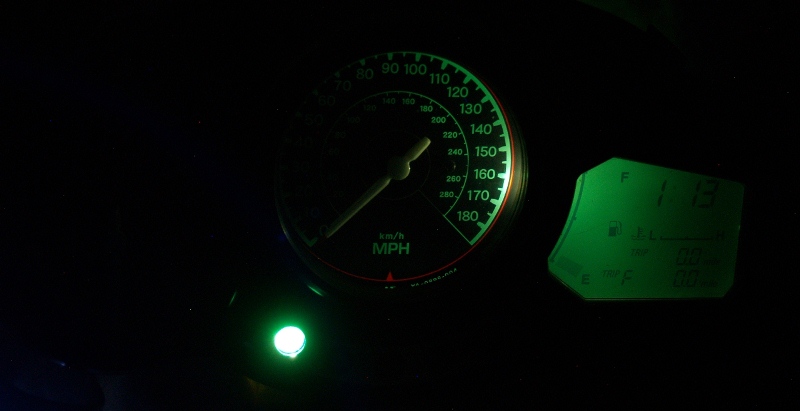
Then a stock light bulb on the left and 100 on the right for comparison. Notice the even fill of the stock light. However, the color of the lights is very similar.
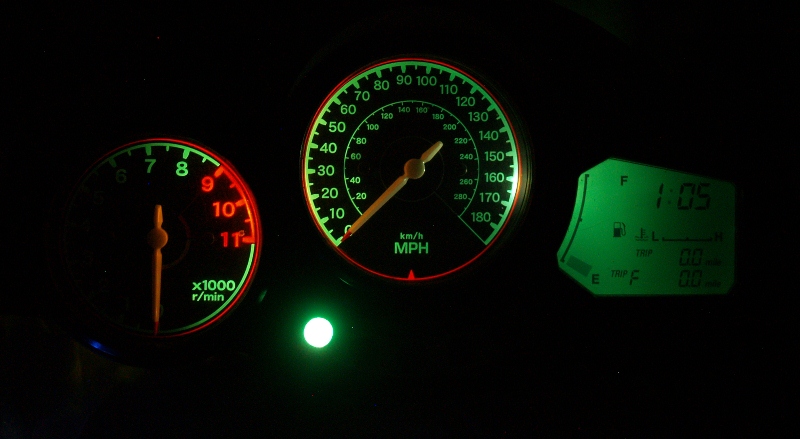
Then I tried a 120 degree white LED instead of the 100. Exposure is brighter, but the fill seems a little better. Still a bit of a hot spot, but not as bad.
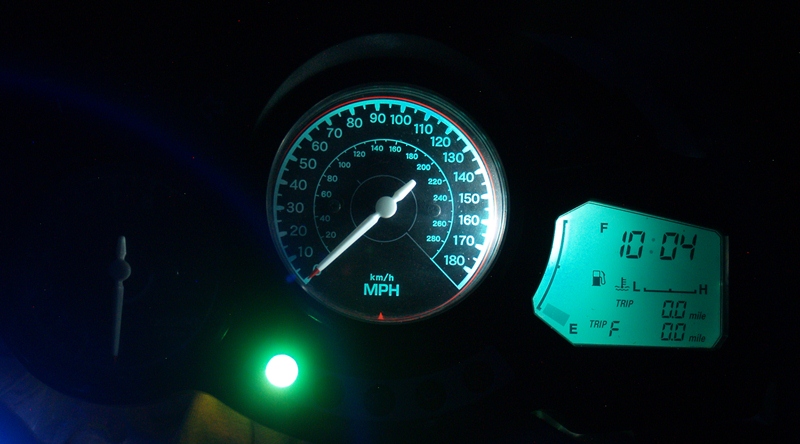
Then let's try 4 white 120 degree LEDs....pretty decent with some hotspots and glare....but 99 years of life or 25,000 miles for the stockers? You decide. I can already tell LEDs are better way to go than stockers.
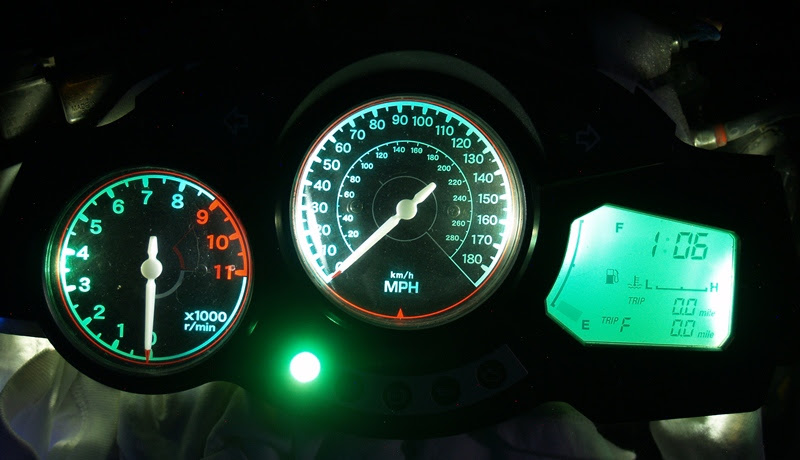
And since I was spending $4 on shipping anyway....how about $9 for some blue LEDs? I didn't hold out a lot of hope, but I gotta tell you in the dark...I REALLY like the blue and think it will be better on those long night desert rides!
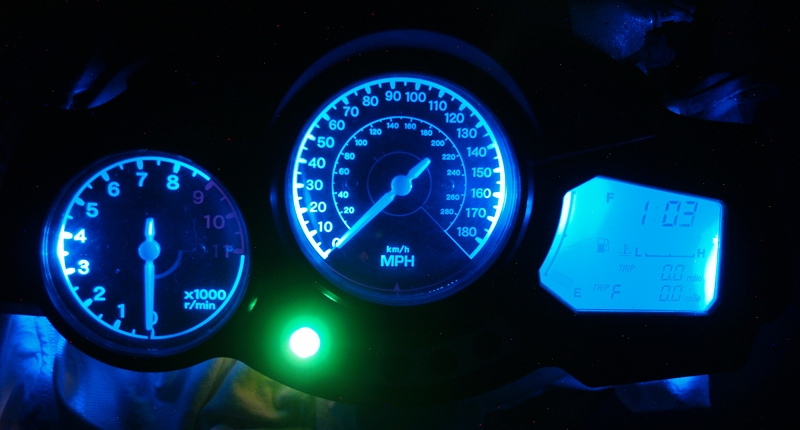
In summary, 4 NEO3-BHP High Power LED Instrument bulbs for the speedo/tach baclights. I like blue, 120 degree, and $2.29 each. Shipping is $4.39 in a nice bubble wrap envelope via USPS for a total of $13.52.
You can replace your OEM filament bulbs with your choice of blue, white, green, red, or amber from SuperbrightLEDS.com.
I'll report back after I go on a long ride with them and decide.
Ignacio with big props to Ionbeam
.
.
.
And for the ultra-bonus. From left to right......Green-Blue-White-Amber 120 degree LEDs.
Don't try this at home....it's not safe! I'm what you call an LED ghey rainbow professional.

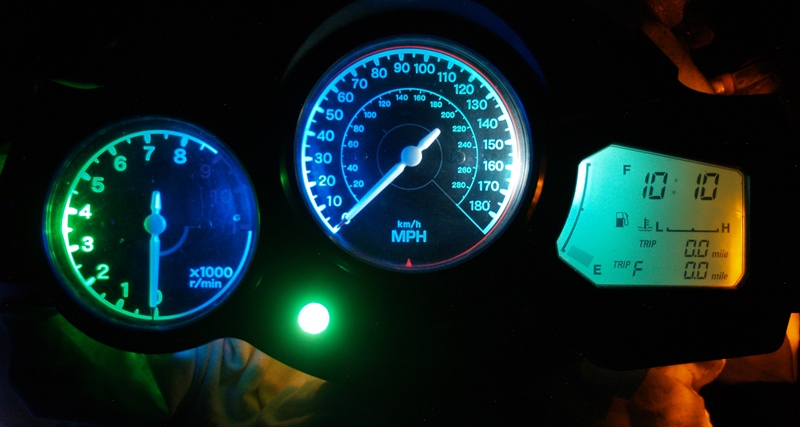
That potentially changed when our Illustrious Illuminati Ionbeam sourced these potential 120 degree LED replacement lights from SuperbrightLEDs.com. And since I had the nose off my old FJR and going to take the nose off my new FJR...a perfect time to drop $30 and do some experimentation.
clickable pic:

I bought a few different colors mostly in the 120 degree variety, but a white 100 degree light just in case and tried it first. First pick is with a 100 degree white LED in place..and pretty obvious hot spot around the 160mph area. I also noticed the 100 degree lights have an extra long bit of plastic glued to them and would interfere with part of the panel in one of the positions. Also note the LEDs have a polarity, so if the light doesn't turn on you have to remove it and install 180 degrees differently.

Then a stock light bulb on the left and 100 on the right for comparison. Notice the even fill of the stock light. However, the color of the lights is very similar.

Then I tried a 120 degree white LED instead of the 100. Exposure is brighter, but the fill seems a little better. Still a bit of a hot spot, but not as bad.

Then let's try 4 white 120 degree LEDs....pretty decent with some hotspots and glare....but 99 years of life or 25,000 miles for the stockers? You decide. I can already tell LEDs are better way to go than stockers.

And since I was spending $4 on shipping anyway....how about $9 for some blue LEDs? I didn't hold out a lot of hope, but I gotta tell you in the dark...I REALLY like the blue and think it will be better on those long night desert rides!

In summary, 4 NEO3-BHP High Power LED Instrument bulbs for the speedo/tach baclights. I like blue, 120 degree, and $2.29 each. Shipping is $4.39 in a nice bubble wrap envelope via USPS for a total of $13.52.
You can replace your OEM filament bulbs with your choice of blue, white, green, red, or amber from SuperbrightLEDS.com.
I'll report back after I go on a long ride with them and decide.
Ignacio with big props to Ionbeam
.
.
.
And for the ultra-bonus. From left to right......Green-Blue-White-Amber 120 degree LEDs.
Don't try this at home....it's not safe! I'm what you call an LED ghey rainbow professional.

Addendum: 5 years later and I'm still running the white set of LEDs in my original FJR. Best thing I ever did to convert to LED. What I lost in evenness of illumination was more than made up in peace-of-mind not having to change bulbs every couple of years. I sold off the instrument cluster with the blue lights, but I'd consider that as a viable alternative. Less hotspots and better levels for the dark night, but not quite as much contrast on the gauges.
Last edited by a moderator:





